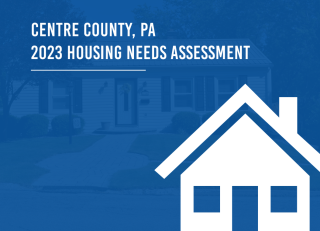A Look at the 2023 Housing Needs Assessment for Centre County

The Centre County Commissioners authorized the development of the 2023 Housing Needs Assessment for Centre County in early 2022 and engaged Mullen & Lonergan Associates as the consultant for the project. The study is an update and revision of the 2005 Centre County Affordable Housing Needs Assessment: A Blueprint for Action. The 2023 Housing Needs Assessment for Centre County analyzes housing markets by market type and provides options for addressing deficiencies within the existing inventory, suggests methods that various stakeholders can make to increase supply of affordable units, and recommends partnerships and strategies to meet overall housing needs. Centre County Government and many affordable housing stakeholders engaged with M&L Associates to provide insight and experience with a growing concern for deficiencies in affordable housing spread across many regions of Centre County.
Key Findings within the 2023 Housing Needs Assessment for Centre County
Housing Inventory
Single-Family (59.8%), 2-19 Units {18.46%), 20-49 Units (5%), 50+ Units (5.6%) and Mobile Homes, etc. (4.7%)
Lack of Diverse Housing Types and the Missing Middle
The majority of missing housing types have 4-8 units in a building or 4-8 units on a lot. (e.g. Duplex Side-by-Side + Stacked, Fourplex, Townhouse, Cottage Court)
Cost Burden (Paying more than 30% of Income on Housing Costs)
- 29.1% of households were cost burdened in 2018
Renters: 49.7% (one in two)
Owners: 16.3% (one in six) - 0-30% AMI Households:
Renters: 70.87% (three in four)
Owners: 75% (three in four) - 31-50% AMI Households:
Renters: 79.10% (four in five)
Owners: 48.48% (one in two)
Median Household Income increased only 10% when adjusted for inflation (2010-2020)
- 17% of households lived in poverty in 2020 ($26,200/family of four)
- 28% of households were Asset Limited, Income Constrained, Employed (ALICE) ($72,108/family of four)
- ALICE Households increased by 21% between 2016-2018 while total households increased only by 2%
(6) Occupations that cannot afford a one-bedroom housing wage ($17.02/Hr.)
- Transportation and Material Moving ($14.55)
- Building & Grounds Cleaning & Maintenance ($14.39)
- Healthcare Support ($14.17)
- Sales and Related ($13.63)
- Personal Care and Service ($13.24)
- Food Preparation and Serving Related ($11.26)
- Households younger than 35 have a 78% renter rate and Renting declines as age of householder increases until age 65
Owner Occupied Housing Costs
- Centre Region: 54% of Units at $300,00 and higher & 14.8% of units less than $200,000.
- Balance of County: 22% of Units at $300,000 and higher & 55.3% of Units less than $200,000.
Rental Housing Costs
- Centre Region: 58.6% of units at $1,000/month and higher & 16.1% of units less than $750/month
- Balance of County: 23.5% of units at $1,000/month and higher & 45.2% of units less than $750/month
Housing Gap
Households above 100% AMI are occupying housing units affordable to lower income households and are the largest group occupying housing that is affordable to 31-80% AMI Households, creating a housing gap at all income tiers between 0-100% AMI despite there being more affordable housing units than households in each of the lower tier AMI categories.
Impacts on the Housing Market
- Supply Chain Delays
- Building material and land costs
- Rising Sale Prices
- Low Sales Inventory
- Mortgage Rates
- Student Rental Market
- Zoning & Land Use Regulations
- Lack of Supporting Infrastructure
| Attachment | Size |
|---|---|
| 38.59 MB |

